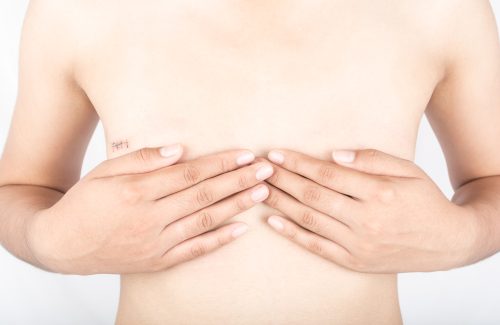Going Flat after Mastectomy
Going Flat
Going flat means choosing not to have breast reconstruction after mastectomy. Choosing to go flat or to have reconstruction is a very personal decision.
This section covers the following topics:
What are the reasons to go flat?
You may choose not to reconstruct because you:
- want to avoid additional surgery.
- want to return to your normal routine as quickly as possible.
- are comfortable with the idea of a flat chest.
- are undecided about reconstruction at the time of mastectomy.
- have a health condition that precludes additional surgery.
- need radiation after mastectomy. (For reconstruction after radiation, the plastic surgeon can insert and inflate a tissue expander after mastectomy to preserve the breast skin and shape for later reconstruction—this is called a “delayed-immediate” procedure).
What happens when you go flat?
If you choose to go flat, the breast tissue and most of the breast skin is removed, leaving the chest flat or slightly concave. The incision will typically run across the middle of the chest. It may be possible for you to have nipple sparing mastectomy, even if you choose not to reconstruct. Make sure to ask your surgeon for an "aesthetic flat closure" as defined by the National Cancer Institute so they understand you want a smooth, comfortable flat chest with no extra skin left behind.
You can change your mind about going flat and undergo delayed reconstruction with tissue or implants at any time in the future.
Using prostheses
Some people who go flat like to wear breast-shaped forms (prostheses) that adhere to the chest or can be tucked into specially-made bras, camisoles, lingerie and swimsuits to temporarily restore their natural shape and profile. Prostheses come in a variety of shapes, sizes, textures, weights and with or without nipples. Customized silicone prostheses are the most realistic and the most expensive. Prostheses can be especially helpful after unilateral mastectomy to better fit into clothing and restore balance. A qualified fitter can help you find the right prostheses that fits your chest properly.
Goldilocks mastectomy
If you don’t want a completely flat chest after mastectomy but also don’t want (or can’t have) breast reconstruction, you might consider a Goldilocks mastectomy. It is a skin-sparing mastectomy—the surgeon removes the breast tissue and then rearranges the breast skin and underlying fat to create a small breast mound. Results tend to be better for patients with very large breasts who have more fat to work with. No additional surgeries are required, although later fat grafting (an outpatient procedure) can improve volume and contour without the need for breast implants or donor sites.
You may choose to keep your nipples and areolas if they are clear of cancer cells, although they may flatten or look and feel differently. Other options would be to have them reconstructed or tattooed onto your breast mounds or simply leave your breast mounds without nipples.
The Goldilocks procedure may be as safe as other skin-sparing mastectomies. However, no large, long-term clinical studies have identified appropriate candidates, specific risks or shown long-term safety data.
Not all breast surgeons, general surgeons or surgical oncologists offer the Goldilocks procedure, so it is important to ask about a surgeon’s experience with this procedure. Ask to see photos of their Goldilocks patients, and discuss what you can expect in terms of the surgery, recovery and results.
In the News
Community Stories
February 27, 2017
February 23, 2017
Risk-Reducing Mastectomy
Risk-reducing mastectomy lowers the risk for breast cancer in high-risk individuals. Read more about this procedure.
Types of Reconstruction
Breasts can be reconstructed using implants, living tissue or a combination of the two. Read more about each type of reconstruction. .
Nipples and Areola
People who do not have nipple-sparing mastectomy may choose to have nipple reconstruction and areola tattooing. Learn more about these procedures.
Preparation and Recovery
Learn about the steps that you can take to prepare for mastectomy and reconstruction and help with recovery.
Photo and Video Gallery
View images and videos of mastectomy with and without reconstruction shared by members of the FORCE community.
Checklist and Tip Sheet
View questions to help you make medical decisions and tips to help you prepare for and recover from surgery.



